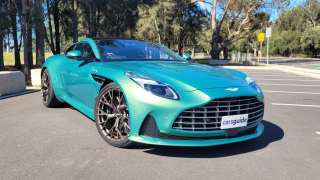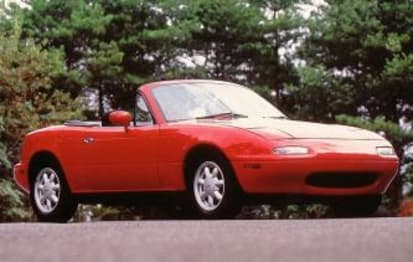
Used Mazda MX-5 review: 1989-2014
- Mazda MX-5
- Mazda MX-5 2006
- Mazda MX-5 2007
- Mazda MX-5 2009
- Mazda MX-5 2012
- Mazda MX-5 2013
- Mazda MX-5 2008
- Mazda MX-5 2011
- Mazda MX-5 1989
- Mazda MX-5 1993
- Mazda MX-5 2014
- Mazda MX-5 1990
- Mazda MX-5 1991
- Mazda MX-5 1992
- Mazda MX-5 1994
- Mazda MX-5 1995
- Mazda MX-5 1996
- Mazda MX-5 1997
- Mazda MX-5 1998
- Mazda MX-5 1999
- Mazda MX-5 2000
- Mazda MX-5 2001
- Mazda MX-5 2002
- Mazda MX-5 2003
- Mazda MX-5 2004
- Mazda MX-5 2005
- Mazda MX-5 2010
- Mazda MX-5 Reviews
- Mazda Reviews
- Mazda Convertible Range
- Convertible
- Mazda
- Used Car Reviews
Mazda MX-5 totally changed the thinking in the automotive world when it was introduced to a surprised world in 1989. Prior to that most car makers felt that ever stricter safety regulations meant it was all but impossible to make a car safe unless it had a roof. Mazda proved it could be done and the MX-5 has since become the biggest selling roadster of all time.
The rest of the world's car makers took a close look at the engineering (and sales) of the little Mazda - and today it's hard to find a marque that doesn't have at least one open-top car on its sales list.
The little Mazda roadster is a sheer delight to drive. Its great road grip, near-neutral balance and pin-sharp steering provide exactly the type of car that appeals to keen drivers. The slightest hint by the driver to the steering wheel seems to be all that's needed - there really is a feeling the MX-5 is responding to the driver's mind not just their hands and feet. Owners just love to take them for a quick blast along their favourite stretch of road on a sunny Sunday morning.
The Mazda MX-5 was launched in Australia in October 1989 and remained almost unchanged in its body until March 1998, when a near-new car was introduced. The original model had pop-up lights, every one since then has fixed lights. At the same time, an increase in boot space made the MX-5 a more practical car, one that could be used by a couple on holiday jaunts with a bit of careful packing.
A facelift in October 2000 saw the rounded grille replaced by what Mazda calls a five-point grille to bring it into line with the styling theme of the rest of the Mazda family at the time. An all-new MX-5, the NC series, arrived in September 2005. It was slightly larger than before, though weight increases were kept to a minimum.
With a couple of updates along the way this model is still current on the new market. A new model is imminent and expected in the first half of 2015.
Many drive with the top down even if the weather is threatening, well aware the soft-top only takes seconds to close, something that can be done when stopped at a red traffic light. You should have a supple body though, because a fair bit of upper body twisting and shoulder strength is needed.
A folding hardtop roof made things much simpler when introduced in September 2006. It not only works neatly, but adds a minimum of weight to the car and takes little away from luggage carrying capacity. So popular did the folding hardtop become in Australia that imports of the soft-top slowed, and ceased altogether towards the end of 2012, some of these may not have been registered until early 2013. There's a school of thought that says used soft-top MX-5s may increase in popularity due to their rarity. No promises, though...
Engine power isn't quite as impressive as the chassis dynamics; the original MX-5 only had 1.6 litres. That was lifted to 1.8 litres in November 1993 in a new engine that was slightly modified, with an emphasis on a wider spread of torque. Surprisingly, it wasn't as happy to rev as previously; it's okay, but a willing engine in a sportscar is a delightful thing.
The 1998 model change kept the engine at the same size but gave it a little more punch. In October 2000, the engine received a new variable valve timing system to improve power and torque. Response was significantly improved, but is still nothing to get excited about.
A 2.0-litre engine was introduced in the new 2005 NC series MX-5 and is arguably the best yet. Changes to the engine in 2009 and again in 2012 saw it able to rev to higher numbers. Low down grunt was improved at the same time, something that's not always easy to do.
The gearchange on the Mazda MX-5 is one of the sweetest units you will ever meet
Anyway, half the fun of driving a little roadster like this is rowing it along on the gearbox, going for the right gear at the right time to make the best of the engine's relatively limited power.
The gearchange on the Mazda MX-5 is one of the sweetest units you will ever meet, with short positive changes that not only work well but feel great at the same time. Keen owners say the relative lack of engine power is actually a bonus because it gives them good reason to use the gearbox.
Earlier manual gearboxes were five-speed units. A six-speed was used in the 10th Anniversary limited edition of 1999, and became standard in the October 2000 model. The six-speed is a close-ratio unit, in fact the overall top gear ratio in both boxes is pretty much the same. To our way of thinking the six-speed isn't quite as pleasant in its feel as the latter five-speed units.
An automatic transmission with six forward ratios became an option in 2005. Sporty programming of its electronics means it's not far short of a manual in driving pleasure. But give us a 'proper' manual any day!
Good design and high build quality mean the MX-5 is reliable. It's fairly easy for a good amateur mechanic to work on and spare parts are normally reasonably priced. The Mazda dealer network isn't huge but works effectively and we have heard of no real complaints about spare parts availability.
Insurance can be expensive, particularly for young and/or inexperienced drivers so it's worth shopping around to get the best deal. As always, make sure you understand what you are getting for your premium dollar.
WHAT TO LOOK FOR
It's probably best to keep clear of MX-5s that have been used in lap dashes at race tracks or in rallies - unless, of course, you're planning to take part in the fun yourself and need the necessary safety mods.
Track MX-5s can often be recognised by tyre scrubbing (if different tyres haven't been used on the track), a rollcage, fire extinguisher or extra instruments. Heavy deposits of brake dust on the callipers and the inside of the wheels may be sign of racetrack use, or simply of hard on-road driving.
In early models look for stitching that's worn or broken in the soft-tops. Discolouration in the plastic rear window in early models ruins the looks, but isn't overly expensive to repair. A glass rear window was used from 1998 and is probably the best choice for all but the MX-5 purists.
Look for crash damage that's been repaired, indeed it may be very wise to call in a professional if you are in any way suspicious. Be suspicious of water stains on the seats and trim, check under the carpets for dampness or rust as the MX-5 may have been caught with its top down in the rain.
The engine should start easily, idles reasonably smoothly and not blow smoke from the exhaust under hard acceleration. The gearbox should be light and positive in its change action and not baulk or crunch even on the fastest of changes. The third-second change is usually the first one to suffer.
CAR BUYING TIP
Sportscars that have been driven in a sporty manner are relatively rare, so may be best avoided when shopping around for a used one.
Pricing
| Year | Price From | Price To |
|---|---|---|
| 2014 | $13,640 | $26,070 |
| 2013 | $12,430 | $23,870 |
| 2012 | $11,990 | $22,660 |
| 2011 | $11,660 | $19,470 |
| 2010 | $10,230 | $17,930 |
| 2009 | $9,020 | $20,240 |
| 2008 | $8,580 | $16,720 |
| 2007 | $7,810 | $14,850 |
| 2006 | $6,600 | $12,540 |
| 2005 | $6,600 | $11,000 |
| 2004 | $6,380 | $10,230 |
| 2003 | $5,610 | $11,550 |
| 2002 | $5,170 | $11,000 |
| 2001 | $5,830 | $8,910 |
| 2000 | $5,500 | $9,460 |
| 1999 | $5,500 | $9,460 |
| 1998 | $5,500 | $9,350 |
| 1997 | $3,850 | $6,600 |
| 1996 | $3,850 | $6,600 |
| 1995 | $3,850 | $6,600 |
| 1994 | $3,850 | $6,600 |
| 1993 | $3,190 | $6,600 |
| 1992 | $3,190 | $6,380 |
| 1991 | $3,190 | $6,380 |
| 1990 | $3,190 | $6,380 |
| 1989 | $3,190 | $6,380 |
Pricing guides
Range and Specs
| Vehicle | Specs | Price* | |
|---|---|---|---|
| (base) | 1.6L, ULP, 5 SP MAN | $3,190 – 5,060 | 1989 Mazda MX-5 1989 (base) Pricing and Specs |
$3,190
Lowest price, based on third party pricing data










